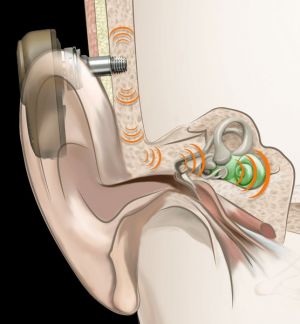Sometimes, hearing aids are not the best option for people with hearing loss, and bone-anchored hearing systems are suggested as a more suitable option. Yet, many people aren’t aware of what they are and how they work.

seen here, is a bone-anchored hearing
system that fits behind the ear.
Photo courtesy Oticon Medical.
Unlike hearing aids, bone-anchored hearing systems are surgically implanted devices. They treat hearing loss through bone conduction of sound vibrations to the inner ear—this is in contrast to regular hearing aids, which amplify acoustic sounds that enter the ear canal. For this reason, bone-anchored systems are considered specialty devices for certain hearing loss conditions, which are described below.
Bone-anchored hearing systems, also known as bone-anchored auditory implants, are not to be confused with cochlear implants. While they are also a type of surgically implanted device for hearing loss, the patient indications are different. In other words, they treat different hearing problems. To learn more, see our page on cochlear implants.
Here’s what to know:
Table of Contents
Why bone-anchored hearing systems?
Bone-anchored hearing systems work best for people who have at least one inner ear that functions normally. They may have conductive hearing loss (their outer or middle ears do not transmit sound correctly) or complete hearing loss in one ear only. Candidacy is best determined by a hearing care professional like an otolaryngologist (ENT).
These types of devices bypass particular problems by sending sound vibration directly to the inner ear through the skull bone. This can be helpful because middle ear and ear canal problems might prevent sound waves and signals from reaching the inner ear. In those cases, standard hearing aids are ineffective.
The most likely candidates for bone-anchored hearing devices are children or adults who have severe outer or middle ear malformations, or those with single-sided deafness.
That’s why people who typically get the greatest benefit from bone-anchored hearing systems include those who have severe outer or middle ear malformations and those with single-sided deafness, also known as unilateral hearing loss. This type of hearing solution also may be recommended in extreme cases of chronic ear infections or allergies to traditional hearing aids.
Malformations of the outer or middle ear
Malformations of the ear canal or middle ear, such as narrowing of the ear canal or a malformed or absent pinna (external ear) cause conductive hearing loss. These malformations are often congenital, or present at birth. A bone-anchored hearing solution delivers sound vibrations directly to the inner ear by being in direct contact with the skull bones. EarCommunity.org has a photo gallery of people with these conditions wearing bone-anchored hearing systems.
Single-sided deafness
Single-sided deafness (SSD) is a condition in which a person has lost all hearing in one ear, while having anywhere from normal hearing to profound hearing loss in the other ear. Single-sided deafness makes it difficult to determine which direction sound is coming from (localization) and diminishes the ability to understand speech in noisy environments.
Common causes of SSD include acoustic neuroma (a tumor on the hearing nerve), Meniere’s disease or sudden sensorineural hearing loss. If you have single-sided deafness, you can wear a special pair of hearing aids that route sounds from the poorer hearing side to the better hearing side (called a CROS device), but a bone-anchored hearing device may be preferable because it requires the use of only one discreet device.
Additional criteria for wearing a bone-conducted hearing device
Because a bone-anchored hearing device does not block the ear canal, there are other, rarer conditions that might warrant this type of hearing treatment. For example, people with chronic ear infections may have difficulty wearing traditional hearing aids if they experience drainage of fluids from the middle ear into the ear canal. People who have extreme allergies to the materials used to fabricate custom hearing aids and earmolds may also prefer a bone-anchored system.
How does it work?

bone-anchored hearing system.
(Photo courtesy Oticon Medical.)
Bone-anchored hearing devices have two parts: a titanium bone implant and an external sound processor. The external microphone and sound processor of the bone-anchored device picks up sounds and converts them into vibrations to the embedded implant. In turn, the implant vibrates the surrounding bone, which sets up sound waves in the inner ear that stimulate the hair cells and result in the firing of the auditory nerve.
What happens during surgery?
During an outpatient surgical procedure, an ear-nose-throat doctor or other surgical specialist places a small titanium implant (3-4 mm) into the mastoid bone behind the ear. The implant may have a small abutment that sticks out through the skin for attaching the external part of the device. Over time, the titanium implant integrates with the bone. The removable microphone and sound processor can then be attached via a built-in magnet or by clipping onto the abutment.
The goal is that all parts fit snugly together, as a snug fit helps hearing implants convey vibrations through the bone more effectively.
The kind of operation you receive will be different depending on which manufacturer’s system you choose. For example, Oticon Medical utilizes MIPS (minimally invasive Ponto surgery), which takes an average of 15 minutes to perform and usually only requires local anesthesia. MIPS reduces the likelihood of complications because it doesn’t require suturing, which eliminates scarring and fosters rapid healing.
MIPS also reduces the likelihood of complications because it leaves more of the skin, blood vessels, and nerves intact. The operation was designed to create the smallest incision possible, leaving the skin and hair follicles around the new abutment intact. Recovery typically requires only a day or two of rest before you can return to your normal activities. With few exceptions, most candidates for a bone-anchored hearing device can safely undergo MIPS.
If you’re considering a bone-anchored device, but first want to get a sense of if this type of device would work well for you, your doctor or audiologist may let you try out traditional bone conduction hearing aids (which don’t require an implant or any surgery). Or, they may help you try out simulation devices.
Can you hear right away?
The skull and skin have to heal before the external device can be clipped on or magnetically connected. The time needed for healing is specified differently by each manufacturer, from 3 weeks to 3 months. Once the external device is attached, it can be programmed for the patient’s specific hearing loss. Wearing a bone-anchored hearing system would be similar to wearing an acoustic hearing aid at this point—there may be some adjustments needed as the patient gets accustomed to hearing and listening to amplified sounds.
What’s it like to have a BAHA or a bone-anchored device?
Patient stories

Kevin Hotaling was born with severe congenital hearing loss on his left side, a condition he treated with hearing aids all the way through high school. In his mid 20s, Kevin Hotaling upgraded to a bone-anchored hearing system. More: What this Millennial wants others to know about his bone-anchored hearing system

Lucy Brown is an active pre-teen who dreams of one day becoming an ear, nose and throat doctor as well as a member of the Olympic gymnastics team. Her bone-anchored hearing system lets her hear conversations in noisy situations like gym practice. More: Engaged, assertive and confident: Lucy’s bone-anchored hearing story
On the market
Currently, there are two manufacturers with FDA-approved bone-anchored hearing devices: Oticon Medical and Cochlear Americas. Each device brand fits a little differently but they’re both placed behind the ear on the mastoid bone. Indications for child wearers may require a soft headband to ensure the device stays in place during active play.
What is a BAHA?
People sometimes refer to any brand of bone-anchored hearing devices as a BAHA (short for “bone-anchored hearing aids”). However, BAHA™ also is the name of a specific brand of bone-anchored hearing aid, made by the Cochlear Americas company. People also may refer to any of the several brands as a “bone-anchored hearing device,” or a “bone-anchored hearing system” (BAHS).
What is a Ponto?
Ponto™ is the brand name of Oticon Medical’s bone-anchored processor, and various models have been on the market since 2009. Currently only the Ponto 3 SuperPower and Ponto 4 are available for sale. The 2019 release of Ponto 4 is the smallest available bone-anchored hearing device currently on the market that also offers full wireless capabilities.
The retail price for the Ponto 3 SP is $5,460 and Ponto 4 is $5,495. It should be noted that Ponto devices can be worn on a soft band, which is appropriate for: children under the age of five, wearers who only require temporary hearing assistance or just trying it out, and anyone with physical conditions that preclude implantation (e.g., lack of sufficient skull density).
What kinds of accessories work with bone-anchored hearing aids?
The accessories and apps available for bone-anchored hearing device users are very similar to those used by regular hearing aid wearers, and are often referred to generally as assistive listening devices. They include:
- Audio streamers – relay devices worn around the neck or as clips that allow wearers to stream sound from televisions, cellphones, or music players directly into their sound processor.
- FM/DM receiver – frequently used by students to tap into a school’s FM system and stream a teacher or lecturer’s voice directly into the wearer’s processor. Very helpful in crowded, noisy, or large, echoing venues like auditoriums.
- TV streamers – these can be hooked up to most televisions or computers and allow bone-anchored device wearers to stream the audio wirelessly directly into their BAHA for greater clarity and speech comprehension.
- Smartphone apps – depending on how advanced your bone-anchored hearing system is, you might be able to use an app to learn how to use your new BAHS or control your device’s volume and other functions right from your cellphone. These apps are typically provided free of charge from Oticon Medical or Cochlear Americas and can be downloaded from the Google Play™ or Apple® App stores. Ask your manufacturer which ones are compatible with your specific device.
How much does a bone-anchored hearing device cost?
While the exact cost of surgery differs depending on the kind of operation to implant the device you have and other criteria, the average cost is between $10,000 and $17,000. In addition, the sound processor price ranges between $5,000 and $8,000 depending on the manufacturer you choose, and the kinds of features included in the specific device.
The good news? Bone-anchored hearing aids and the procedures to implant them are frequently covered by insurance, at least in part. To find out what your insurer will cover, contact them for details. Most manufacturers also offer insurance support staff to assist you with checking your coverage and help you appeal a denial or find other options to afford your bone-anchored hearing system if needed.
Interested in a bone-anchored hearing system?
If you think you may be a candidate for a bone-anchored hearing system and you would like to find out more, contact an ear, nose and throat doctor in your area, or you can search this directory of providers from Oticon Medical.

